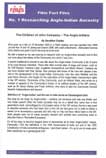Difference between revisions of "Research guides reading list"
EleanorNeil (talk | contribs) (Cover image) |
EleanorNeil (talk | contribs) (Adjusted placement of image) |
||
| Line 34: | Line 34: | ||
| − | * ''Researching Anglo-Indian ancestry''. Weybridge: Families in British India Society, 2009 (FIBIS fact files; 1) | + | * ''Researching Anglo-Indian ancestry''. Weybridge: Families in British India Society, 2009 (FIBIS fact files; 1)[[Image:FFF1.jpg|right]] |
| − | + | Essential for any family historian with blended ethnicity. The booklet contains two expanded and updated articles previously published in the FIBIS ''Journal'': ''The children of John Company : the Anglo-Indians'' by Geraldine Charles, and ''A Luso-Indian voyage'' by Cliff Pereira. These two authorities provide invaluable information: definitions of the various terms used for those of mixed race in the Indian sub-continent, a brief background history of these communities, reading lists, and, by using their own families as a basis, a demonstration of how to effectively research Anglo-Indian ancestors. | |
Revision as of 21:04, 3 May 2009
- Bailey, Peter
Researching ancestors in the East India Company's Armies. [s.l.]: Families in British India Society, 2006. (FIBIS research guide; 1)
This is the essential handbook for anyone researching ancestors who were connected to the HEIC Armies of Bengal, Bombay, and Madras. It covers records from the armies' origins until their assimilation into the British Army by 1860. Laid out in a clear and accessible manner, the book directs searchers to records on all available stages of a man's career, whether officer or soldier, including sources which may provide details on his wife and children. For those researchers not fortunate enough to have access to the India Office Records at the British Library, the LDS film numbers are included. A full review by Richard Scott Morel, Archivist of Pre-1858 India Office Records, is available on pp. 45-46 of the FIBIS Journal 17 (Spring 2007)
- Baxter, Ian A.
Baxter's guide : biographical sources in the India Office Records. 3rd ed. [s.l.]: Families in British India Society in association with the British Library, 2004
This is the bible for all who are researching ancestors in British India and South Asia. The information sought will probably be found in the India Office Records, which occupy 15 km of shelving hidden away in the basements of the British Library. Thankfully, the author provides invaluable guidance on exactly where relevant information may be located for more than forty different categories of people. The reader is also directed to published sources. If confronted by an obscure term while researching, for instance on learning that an ancestor was a clerk in the Sadr Faujdari Adalat, then 'The glossary of terms used in the administration of British India' towards the end of this guide will be enlightening.
- The British overseas : a guide to records of their births, baptisms, marriages, deaths and burials available in the UK. 3rd ed.
London: Guildhall Library, 1994 (Guildhall Library research guide; 2)
Even though some of these records may now be available through the internet, this book is still of use to researchers based in, or able to visit, the United Kingdom.
- Getting started with the India Office Records. Weybridge: Families in British India Society, 2009 (FIBIS fact files; 2)
Planning your first visit to the British Library? This very practical booklet contains two articles which will reduce stress and possible frustration when beginning research in the India Office Records at the British Library in London. Lawrie Butler was the former FIBIS Research Officer and his helpfully illustrated article Hints on research in the India Office Records at the British Library Asian and African Studies reading room carefully sets out what can be accomplished before visiting the library, how to gain admission to the library, and what to do once you enter the reading room in order to obtain maximum results. Elaine MacGregor's article First visits to the OIOC by a 'newbie' is a useful case study recounting her experience of using the same reading room. Both articles were previously published in the FIBIS Journal.
- McLaughlin, Eve
Reading old handwriting. 3rd augmented ed. Haddenham, Bucks.: The author, 1995 (A McLaughlin guide)
Brief but extremely helpful to someone who is new to reading original records. The sample alphabets for various periods are invaluable, as is the section on common abbreviations which includes Christian names which are regularly shortened.
- Researching Anglo-Indian ancestry. Weybridge: Families in British India Society, 2009 (FIBIS fact files; 1)
Essential for any family historian with blended ethnicity. The booklet contains two expanded and updated articles previously published in the FIBIS Journal: The children of John Company : the Anglo-Indians by Geraldine Charles, and A Luso-Indian voyage by Cliff Pereira. These two authorities provide invaluable information: definitions of the various terms used for those of mixed race in the Indian sub-continent, a brief background history of these communities, reading lists, and, by using their own families as a basis, a demonstration of how to effectively research Anglo-Indian ancestors.
- Spencer, William
First World War army service records : a guide for family historians. 4th ed. Kew: The National Archives, 2008
This invaluable guide to locating information on ancestors who served in WW1 has been expanded and updated to refer to many resources which are now available online. The primary source is still the National Archives (TNA) at Kew in England, where in addition to the more obvious Records of Service (British Army officers and other ranks, RAF, WAAC, auxiliary and nursing services) are those of the Indian Army and Dominion Forces. This directs the family historian to a possible treasure trove of records, including those for medals and awards, prisoners of war, unit war diaries and maps.
